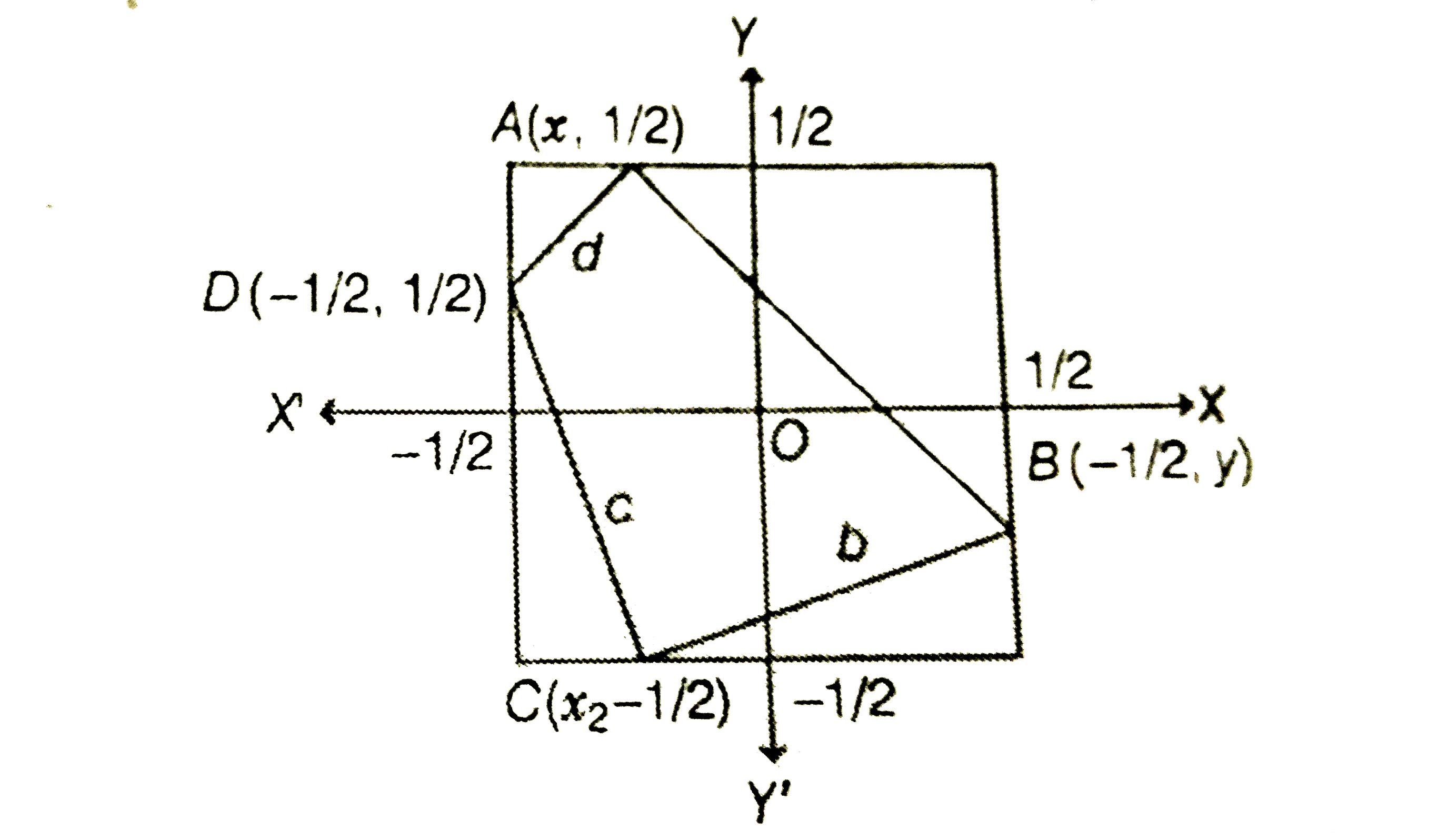Let S be a square of nit area. Consider any quadrilateral, which has none vertex on each side of S. If a,b,candd denote the lengths of the sides of het quadrilateral, prove that 2≤a2+b2+c2+x2≤4.Solution in Tamil
Let the squares S is to be bounded by the lines x=±1/2andy=±1/2
We have, a2=(x1−12)2+(12−y1)2

=x21−y21−x1−y1+12
Similarly, b2=x22−y21−x2+y1+12
c2=x22−y22+x2+y2+12
d2=x21−y22+x1−y2+12
∴a2+b2+c2+d2=2(x21+y21+x22+y22)+2
Therefore, 0≤x21,x22,y21,y22≤14
0≤x21+x22+y21+y22≤1
⇒ 0≤2(x21+x22+y21+y22)≤2
But 2≤2(x21+x22+y21+y22)+2≤4
Alternate solution
c2=x22+y22 ... (i)

b2=(1−x2)2+y21 ... (ii)
a2=(1−y1)2+(1−x1)2 ... (iii)
d2=x21+(1−y2)2 ... (iv)
On adding Eqs. (i), (ii), (iii) and (iv), we get
a2+b2+c2+d2={x21+(1−x1)2}+{y21+(1−y1)2}+{x22+(1−x2)2}+{y22+(1−y2)2}
where x1,y1,x2,y2 all vary in the interval [0,1]
Now, consider the function y=x2+(1−x2),0≤x≤1
differentiating ⇒dydx=2x−2(1−x). For maximum or minimum dydx=0.
⇒2x−2(1−x)=0⇒2x−2+2x=0
⇒4x=2 ⇒x=1/2
Again, d2ydx2=2+2=4
Hence, y is minimum at x=12 and its minimum value is 1/4. Clearly, value is maximum when x=1.
∴ Minimum value of a2+b2+c2+d2=12+12+12+12=2
and maximum value is 1+1+1+1=4
Similar Questions
The area of any cyclic quadrilateral ABCD is given by A2=(s−a)(s−b)(s−c)(s−d), where 28 = a + b + c + d, a, b,c and d are the sides of the quadrilateral. Now consier a cyclic quadrilateral ABCD of area 1sq.unit and answer the following questions:
The minimum perimeter of the quadrilateral is
View SolutionThe area of any cyclic quadrilateral ABCD is given by A2=(s−a)(s−b)(s−c)(s−d), where 28 = a + b + c + d, a, b,c and d are the sides of the quadrilateral. Now consier a cyclic quadrilateral ABCD of area 1sq.unit and answer the following questions:
The minimum value of the sum of the lengths of diagonals
View SolutionThe area of any cyclic quadrilateral ABCD is given by A2=(s−a)(s−b)(s−c)(s−d), where 28 = a + b + c + d, a, b,c and d are the sides of the quadrilateral. Now consier a cyclic quadrilateral ABCD of area 1sq.unit and answer the following questions:
When the perimeter is minimum, the quadrilateral is necessarily
View SolutionA quadrilateral has one vertex on each side of a square of side-length 1. If the lengths of the quadrilateral are a, b, c, d, then
View SolutionIf sinθ1−sinθ2=aandcosθ1+cosθ2=b, then (a)a2+b2≥4 (b) a2+b2≤4 (c)a2+b2≥3 (d) a2+b2≤2
View SolutionLet S be a square of nit area. Consider any quadrilateral, which has none vertex on each side of S. If a,b,candd denote the lengths of the sides of het quadrilateral, prove that 2≤a2+b2+c2+x2≤4.
View SolutionThe area of any cyclic quadrilateral ABCD is given by A2=(s−a)(s−b)(s−c)(s−d), where 2s=a+b++c+d,a,b,candd are the sides of the quadrilateral
Now consider a cyclic quadrilateral ABCD of area 1 sq. unit and answer the following question
The minium perimeter of the quadrilateral is
View SolutionLet S be the square of unit area. Consider any quadrilateral which has one vertex on each side of S. If a, b, c and d denote the lengths of the sides of the quadrilateral, prove that 2≤a2+b2+c2+d2≤4.
View Solution